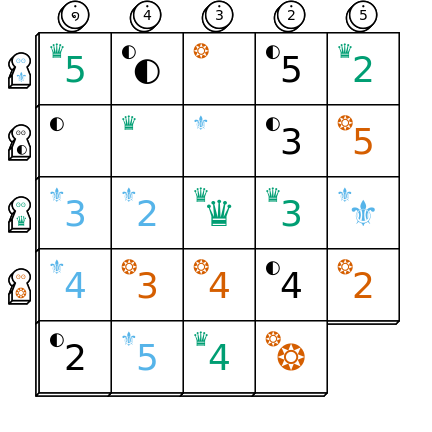| Players | 1-99 |
| Length | 15 minutes and up |
| Equipment Required | one piecepack per player, an opaque bag, and a smooth, flat surface |
| Designer | RANDM Axes Games (RonHaleEvans and Marty Hale-Evans) |
| Version | 0.3.0 |
| Version Date | 2003-03-09 |
| License | originally GNU Free Documentation License, re-licensed CC BY-SA |
Description
Easy Slider is the first game in a new piecepack genre: the "B.Y.O.P.", or "Bring Your Own Piecepack" game. It can be played solitaire, or with as many players as there are piecepacks available. It can even be played over the phone or via online chat.
Players agree on how many rounds of the game they will play. (Three is a good number for beginners.) On each round, a Caller is chosen. (Callers need not rotate.) The Caller creates a random layout of tiles and randomly designates a strict order in which the tiles must be placed. All players then try to slide the tiles on their boards one at a time into the proper positions. The player who does so the fastest over the specified number of rounds is the winner.
Easy Slider is based on the 15 Puzzle and was entered in the third piecepack game design contest, ChangingLandscapes. Mike Schoessow, the judge of the contest, wrote in a followup message to his contest winner announcement on the piecepack list:
- We liked the game fine. As you [Ron] said, its ancestry from the game, 15 is obvious and I think everyone reading this must be familiar with that little solitaire game (my own first exposure to it was when I was 4 years old and my dad gave me one to play with in church to keep me quiet). Easy Slider has a replayability advantage over 15 however because a completely random new board configuration can rapidly be achieved, and because it supports multi-player games. My own opinion is that the replayability improvement is a bigger advantage than the multi-player innovation because I intend to add it to my stable of solitaire games that I actually play (my other favorites are One Man: Thrag, plus some card games).
- One suggestion for the rules is that you should point out that the tile array should be constructed with a little space (we used about 1/4 inch) between adjacent tiles. At first we started with a tight array (all tiles touching neighbors) and of course this was unworkable in a speed game like this because the tile corners kept "catching" on one or more of the flanking tiles ahead, ruining the array. In retrospect the use of spacing between tiles to fix this seems obvious and I'm a little embarrassed to even bring it up but still, I think it wouldn't hurt to put that into the rules text.
- The rules for Easy Slider, as written, make it into a fast-thinking, logical reasoning, dexterity game because of the speed aspect. During play-testing it was realized that an interesting variant is to take away the dexterity aspect and some portion of the fast thinking aspect by preventing the various players from seeing each other's boards and then having the caller announce "slide" at equal time intervals, at which times each player MUST immediately slide a tile. Sliding at other times is not allowed. Thus, at the moment one player wins, all players will have made an identical number of moves. With short intervals the fast thinking aspect is still there but the pressure isn't quite so high and there's more time for deeper planning. The character of the game changes because mistakes are more damaging but there's also more time to think before moving. It also somehow feels like there's more player interaction.
- As you pointed out, this is a game in the same class as Take It Easy, a game I own but seldom pull out on game nights. We found no problems with the rules or game play, and the play-testers were ambivalent about the game; a definite personal preference thing here. There were lots of other fine games this time too, making choices difficult, and when I typed up the announcement I my plan was to announce a winner and runner-up, and then to make a short mention of three or four of my other personal favorites among the games.
The suggestions of Mike and his playtesters were incorporated into the next version of the rules.
--RonHaleEvans
 Example (random) setup for Easy Slider
Example (random) setup for Easy SliderRules
Reviews & Comments
Easy Slider is close enough to the classic 15-tile sliding puzzles to be called an adaptation, and it is a fantastic one indeed. Its use of the Piecepack components (tiles slide, pawns mark rows and coins with their number side up mark columns) is as elegant as it gets, it guarantees a faster and cleaner random setup than the original puzzles (at some point you must be able to remember the moves to scramble a puzzle and simply do them back) and it also allows the game to be scaled down (or even up if you add expansions or use the Packtet). I estimate the level of difficulty of Easy Slider for one single Piecepack roughly as similar to a 15 puzzle - there's more tiles to sort, but the four zero tiles and the gap don't have to be placed in a particular order.
I haven't tried to play the game in a competitive way against other players, but I can imagine it being an easy one to adjust and tinker with (such as Take It Easy!). To be honest, I don't feel any urge to try either: the solitaire game is already enough for me to highlight Easy Slider as one of the best available Piecepack adaptations, and also one of the best solitaires that can be played with a Piecepack.
--Antonio Recuenco Muñoz
CategoryGame SpaceConfigurationPatternCategory MechanicSlidingTilesCategory MechanicRectangularBoardCategory MechanicConstructPatternCategory MechanicMultipleBoardsCategory MechanicRandomBoardCategory
![[Home]](https://ludism.org/logo/pplogo_sm.gif)